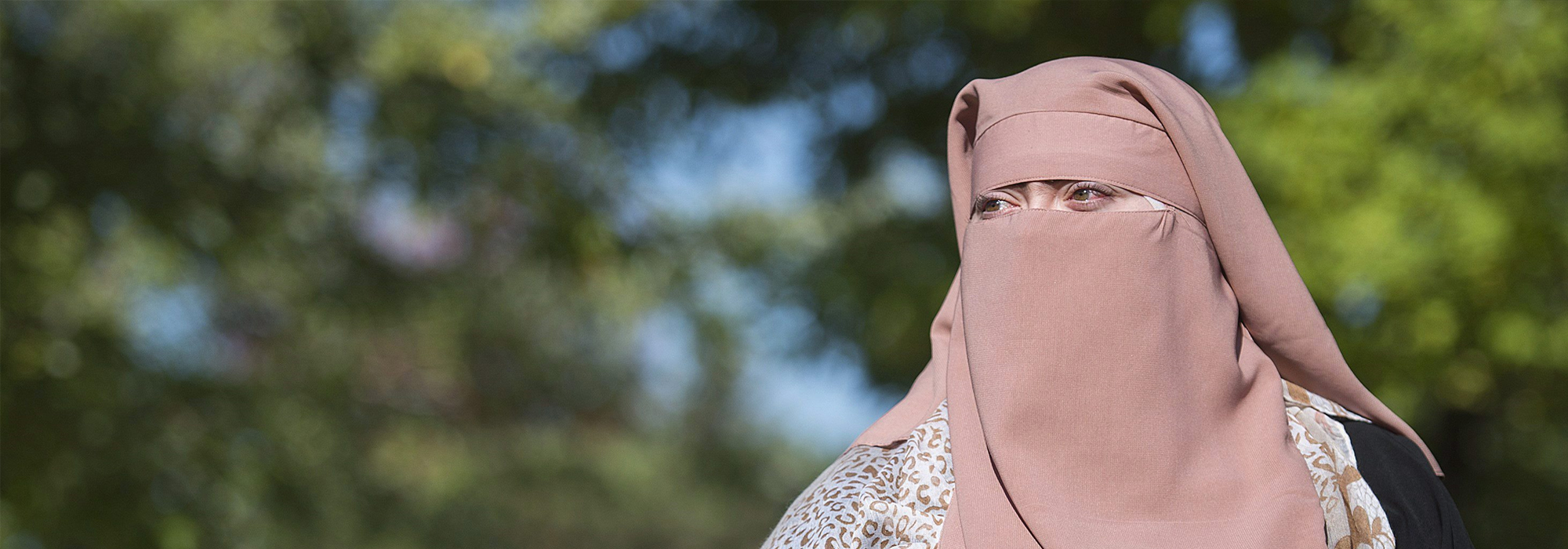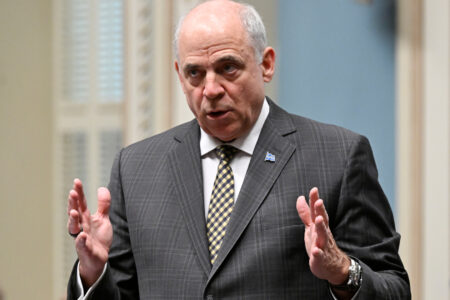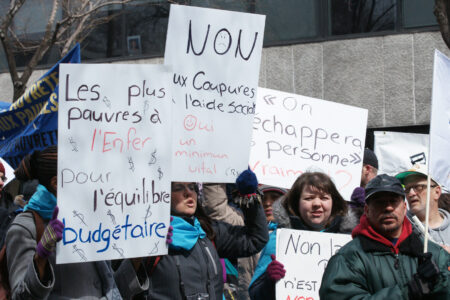
Bill 62, passed on October 18 in Quebec, has spawned another highly charged, difficult discussion about religious differences, inclusion and equality. The bill is the Liberal government’s follow-up to the aborted Charter of Quebec Values, proposed by the Parti Québécois in 2013. That law would have banned overt religious symbols of all kinds in the Quebec public service and some government-funded agencies. The new law is at once more narrow and more broad. Instead of purporting to target all religious symbols, it attacks only “face covering.” But it applies to many more sites of public interaction, including universities, community centres, libraries and, most notoriously, public transit; and it applies not only to those who work for the state but to those who receive its services.
The new law gives rise to obvious legal problems. Its focus on a particular behaviour — face covering — suggests a desire to single out the one religious group that actually engages in that practice: Muslim women. If so, that would be an instance of state animus that is both illegal and unconstitutional. Faced with questions about this animus, provincial officials have stretched the definition of “face covering” to absurd lengths, suggesting that even sunglasses and balaclavas are to be prohibited.
Many have suggested that the law is inconsistent with the Canadian Charter of Rights and Freedoms. Despite calls for the Prime Minister to step in, the federal government lacks the legal standing to directly challenge the law. If an individual affected by the law decides to launch such a challenge, an established legal framework would kick in.
First, a person must show that the law interferes with freedom of religion guaranteed by section 2 of the Charter. Many consider the religious focus of the law to be so obvious, given its context and history, that it displays actual hostility toward Muslims. That would doom the law outright, as it is impermissible for the state to target religious minorities for negative treatment. But courts are generally reluctant to draw such dramatic inferences, and the fact that the law doesn’t refer to the “niqab” or “veiling” likely will be enough to dissuade them from doing so.
The next step, then, is to argue that, in its effect if not its intent, the law violates the Charter. In the public debate about this point, one frequently encounters passionate statements about the nature of the niqab, whether it is actually required by Islam and so forth. Some argue the niqab is not really religious but, at most, a cultural affectation. That argument carries no legal weight. Since 2004, the Supreme Court of Canada has rejected the idea that courts ought to delve into what are, essentially, issues of religious dogma. The Court has held, instead, that the Charter protects any sincere practice that someone thinks furthers their connection to the “divine.” This highly individualistic approach is one about which reasonable people can disagree. But the Court is unlikely to depart from it.
The sheer breadth of services covered by the law should be enough to tip the balance away from a “trivial” interference to one that is pervasive, continuing and even profound.
Second, the interference with religious freedom must be more than trivial. Some have argued that being forced to peel back a niqab for the purpose of brief identification is just not that serious. That argument, too, is unpersuasive. Statements from Quebec Justice Minister Stéphanie Vallée now indicate that a brief unveiling is insufficient: on a bus, for example, a woman will be expected to remain unveiled for the entire ride. And the sheer breadth of services covered by the law should be enough to tip the balance away from a “trivial” interference to one that is pervasive, continuing and even profound.

It is very possible, then, that a person who wears a niqab in Quebec will be able to establish that Bill 62 infringes her Charter rights. That, though, is not the end of the matter. Under the Canadian Constitution, no right is absolute: rights are subject to “reasonable limits” under the Charter’s section 1.
Here, too, the case law provides for numerous steps. First, the state must prove that the law is intended to further a “pressing and substantial objective”: that its purpose is compelling enough to justify infringing the Charter. In most cases, establishing such a purpose is straightforward. On this law’s purpose, though, the messages coming from the Quebec government have been confusing, even contradictory.
Clearly, many persons view the niqab itself as entirely contrary to Canadian and Quebec values.
Regardless of what niqab-wearing women might say about the matter, these critics argue that the face covering should be banned on the basis of the negative message it conveys about women in general. It could be difficult to establish that a purely symbolic purpose is a “pressing and substantial objective.” In any event, the Quebec government has not made such an argument.
The (translated) title of the bill is “An act to foster adherence to State religious neutrality and, in particular, to provide a framework for requests for accommodations on religious grounds in certain bodies.” That would indicate that the law is about promoting a certain understanding of “state neutrality,” or secularism in public affairs. That would be consistent with long-standing political sentiment in Quebec. But the state must be careful not to frame such values in a wholly abstract manner. Otherwise, it risks obscuring the concrete purpose of the law, which leads to difficulties elsewhere in the section 1 analysis.
Note that when Vallée defended the face covering provision, she largely ignored secularism. Premier Philippe Couillard has spoken about the need to protect “communication, identification and security,” telling reporters,“We are in a free and democratic society. You speak to me, I should see your face and you should see mine. It’s as simple as that.” Are we to take it, then, that the law’s most controversial provision is more about setting the parameters for social interaction than about religion? If so, that is similar to the argument accepted by the European Court of Human Rights when, in July 2017, it upheld a Belgian law that bans wearing the burqa in public. It is tricky to say whether that sort of objective would count as pressing and substantial under section 1 of the Charter. Such laws, especially in relation to dress, are extremely rare in Canada and thus have not been the subject of litigation.
Finally, the government also says that the law is aimed at promoting social harmony and peaceful coexistence. Given the reaction in Quebec, which has included public protest and declarations by some mayors of defiance, a reasonable person might be forgiven for thinking that the law has fallen somewhat short. The court probably would accept the promotion of social harmony as a stated purpose, but that in turn could affect the remainder of the section 1 analysis.
Assuming that the law’s objective is pressing and substantial, the next step requires balancing that objective with how the law tries to achieve it. There are three considerations. Is there a “rational connection” between the law’s objective and its means? Does the law achieve those means through “minimal impairment” of the Charter? Is there “overall proportionality” between the law’s positive and negative effects?
If the intent is to promote social harmony and cohesion, the court could find that the law tends to do the opposite.
Rational connection is not a high bar. Indeed, failing at this step suggests a government that is incompetent, irrational or both. Much will depend on what a court accepts as the law’s objective. If the intent is to promote social harmony and cohesion, the court could find that the law tends to do the opposite. The Supreme Court took a similar approach in a 2002 case, Sauvé v. Canada (Chief Electoral Officer), that involved the right of prisoners to vote. The government argued that withholding the franchise as a consequence for law-breaking was necessary to promote good citizenship and overall respect for the law. A 5-to-4 majority regarded that claim as perverse. If the court focuses on other stated purposes, described above, it may be more likely to find a rational connection.
At the “minimal impairment” stage of the analysis, the government will encounter its most serious challenges. First, the law’s scope is extraordinarily broad, extending to a myriad of ways that citizens access public services. It is difficult to argue that the need for identification is identical in each of these situations. Second, the law was not crafted with much forethought or care about how it would apply. Astonishingly, Quebec decided to pass it with immediate effect, and then farm out to various municipalities and public agencies the work of creating appropriate policies. That is dismissive of the law’s immediate, real-world impact. Third, the government’s insistence that face covering is verboten during the entirety of a public service seems disproportionate, unless the state is able to convince the court that veiling itself, a constitutionally protected activity, is a social problem.
The Quebec government may try to draw an analogy with a 2009 Supreme Court decision involving an Alberta Hutterite community that had challenged a law requiring all licensed drivers to be photographed. There, a 4-to-3 majority upheld the law. It specifically noted that, where a valid state objective directly conflicts with a religious dictate, no accommodation is possible. The state is not required to change public policy to respond to religious beliefs. In my opinion, the 2009 case will be of only limited assistance. That is because, first, a specific requirement of a single licensing program is surely very different from a rule applying to almost all interactions with (not to mention employment by) the state. Second, in the Alberta case the province insisted its objective required perfect compliance with the photo rule, and that no accommodations were possible. As discussed below, the Quebec law specifically includes an accommodation framework.
In Charter cases, the fact that a law actually anticipates individual accommodation often counts in the state’s favour. Accommodation is important to both human rights and equality law. But accommodation arose first in employment situations, where it could be decided on a one-time basis and would not require constant adjustment so long as the person’s circumstances and work duties were unchanged. In the current situation, something else is envisioned. The Quebec law appears to encompass on-the-spot, continual requests of individual state service providers, requiring them to evaluate the sincerity and validity of the request. Meanwhile, putting the burden on Muslim women to make these continual requests is not only unworkable but demeaning.
Thus, the government faces a difficult hurdle in establishing minimal impairment of freedom of religion. But if it somehow is able to surmount it, there is still the final stage of section 1 analysis, which considers the “overall proportionality” between the law’s positive and negative effects. It will be a tall order to persuade a court that the bill’s provisions demonstrate the type of balance required under this part of section 1. Is it really tolerable, in a free and democratic society, to force niqabi women to choose between their religion and health services? To kick them out of university classrooms? To refuse them a bus ride?
In the 2009 Hutterite case, the Supreme Court majority emphasized the fact that, because driving is a “privilege” and not a “right,” drivers are legitimately expected to follow universal rules. The Quebec law operates on an entirely different level. It is difficult to avoid seeing Bill 62 as effecting a sort of social banishment based on political symbolism and strong majority sentiment. As essential as they are to democratic polities, majority desires are dangerous touchstones when weighing the rights of tiny minorities, who are vulnerable in many ways, lack political power and seem to be despised and even feared. That is precisely the sort of situation the Canadian Charter exists to prevent. (It is also the sort of situation anticipated by and protected against in Quebec’s own Charter of Human Rights and Freedoms.) If the Quebec government insists on going down this path, it should not be surprised when 35 years of Charter jurisprudence calls it to account and finds it wanting.
Photo: Warda Naili says the first time she donned a niqab six years ago, it became a part of her. The Quebec woman, a convert to Islam, said she decided to cover her face out of a desire to practise her faith more authentically and to protect her modesty. THE CANADIAN PRESS/Graham Hughes
Do you have something to say about the article you just read? Be part of the Policy Options discussion, and send in your own submission. Here is a link on how to do it. | Souhaitez-vous réagir à cet article ? Joignez-vous aux débats d’Options politiques et soumettez-nous votre texte en suivant ces directives.








